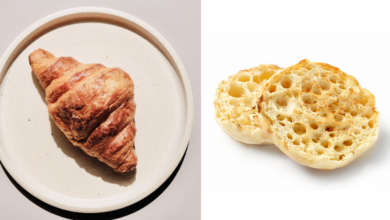Croissant Vs. Bagel: The Ultimate Breakfast Showdown

What To Know
- Made from a dough that is boiled before baking, the bagel has a slightly crispy exterior and a soft, chewy interior.
- The layers of dough and butter create a symphony of flavors, with a hint of sweetness and a touch of salt.
- The croissant’s delicate texture allows the butter to melt in the mouth, leaving a lingering aftertaste that is both satisfying and indulgent.
In the realm of breakfast delicacies, two titans stand tall: the croissant and the bagel. Both have captivated taste buds for centuries, each boasting a unique charm and flavor profile. But when it comes to choosing between these two culinary wonders, which one reigns supreme? Let’s delve into the fascinating world of croissant vs bagel and uncover the intricacies that make them both exceptional.
A Tale of Two Textures
The croissant, a French pastry, is renowned for its flaky, buttery layers that shatter at the first bite. Its delicate texture is a result of the laminating process, where layers of dough and butter are repeatedly folded and rolled. This intricate technique creates air pockets that expand during baking, resulting in a pastry that is light and airy.
In contrast, the bagel, a Jewish bread, is characterized by its chewy, dense texture. Made from a dough that is boiled before baking, the bagel has a slightly crispy exterior and a soft, chewy interior. The boiling process gelatinizes the starch in the dough, giving the bagel its signature texture and distinctive flavor.
Taste and Flavor: A Journey of Discovery
The croissant tantalizes taste buds with its rich, buttery flavor. The layers of dough and butter create a symphony of flavors, with a hint of sweetness and a touch of salt. The croissant’s delicate texture allows the butter to melt in the mouth, leaving a lingering aftertaste that is both satisfying and indulgent.
The bagel, on the other hand, offers a more savory experience. Its slightly salty flavor is complemented by the subtle sweetness of the dough. The bagel’s chewy texture allows for a variety of toppings, from classic cream cheese and lox to savory meats and vegetables.
Versatility: A Culinary Canvas
The croissant’s versatility extends beyond its traditional role as a breakfast pastry. It can be transformed into a variety of culinary creations, from sandwiches and wraps to decadent desserts. The croissant’s flaky layers provide a perfect base for savory fillings, while its delicate flavor pairs well with sweet ingredients.
The bagel, too, is a versatile culinary canvas. Its chewy texture and neutral flavor make it an ideal accompaniment to a wide range of toppings. Bagels can be enjoyed as a simple breakfast with cream cheese or transformed into elaborate sandwiches with meats, cheeses, and vegetables.
Nutritional Showdown: A Battle of Calories
When it comes to nutrition, the croissant and the bagel are on opposite ends of the spectrum. The croissant, with its high butter content, is a more calorie-dense pastry. A typical croissant contains around 270 calories, 13 grams of fat, and 10 grams of sugar.
The bagel, on the other hand, is a more nutritious choice. A plain bagel contains around 240 calories, 1 gram of fat, and 5 grams of sugar. Bagels are also a good source of fiber and protein, making them a more filling and satisfying breakfast option.
Cultural Significance: A Tapestry of Traditions
The croissant and the bagel are both deeply rooted in their respective cultures. The croissant is a symbol of French culinary excellence, often served at breakfast or as an afternoon snack. Its delicate flavor and flaky texture have made it a beloved pastry around the world.
The bagel, on the other hand, is a staple of Jewish cuisine. It is traditionally eaten for breakfast or lunch, often topped with cream cheese, lox, or a variety of other savory ingredients. The bagel’s dense texture and chewy interior have made it a beloved bread in many cultures.
The Verdict: A Matter of Personal Preference
In the great croissant vs bagel debate, there is no clear winner. Both pastries offer unique flavors, textures, and culinary possibilities. The choice between them ultimately comes down to personal preference. If you crave a light, flaky pastry with a rich, buttery flavor, the croissant is your ideal choice. If you prefer a chewy, dense bread with a slightly salty flavor, the bagel is the way to go.
A Culinary Symphony: The Harmony of Croissant and Bagel
While the croissant and the bagel may seem like culinary rivals, they can also coexist harmoniously. Their distinct flavors and textures can complement each other in a variety of culinary creations. From croissant-bagel sandwiches to bagel-croissant bread pudding, the possibilities are endless.
In the realm of breakfast delicacies, the croissant and the bagel stand as two culinary titans, each offering a unique and captivating experience. Whether you prefer the flaky layers of the croissant or the chewy texture of the bagel, there is no denying the allure of these beloved pastries. So, embrace the diversity of breakfast and indulge in the delights of both the croissant and the bagel.
Frequently Discussed Topics
1. What is the main difference between a croissant and a bagel?
The main difference between a croissant and a bagel lies in their texture and flavor. Croissants are known for their flaky, buttery layers and rich flavor, while bagels have a chewy, dense texture and a slightly salty flavor.
2. Which is healthier, a croissant or a bagel?
Bagels are generally considered to be the healthier choice. They are lower in calories, fat, and sugar than croissants and are a good source of fiber and protein.
3. Can I make croissants and bagels at home?
Yes, it is possible to make croissants and bagels at home. However, both pastries require specialized techniques and ingredients. If you are new to baking, it is recommended to start with simpler recipes before attempting croissants or bagels.
4. What are some popular toppings for croissants and bagels?
Croissants are often served with butter, jam, or chocolate spread. Bagels can be topped with cream cheese, lox, smoked salmon, avocado, or a variety of other savory ingredients.
5. What are some creative ways to use croissants and bagels?
Croissants can be used to make sandwiches, wraps, and desserts. Bagels can be used to make sandwiches, breakfast pizzas, and bagel chips.





